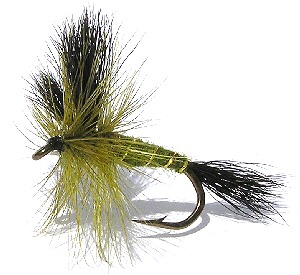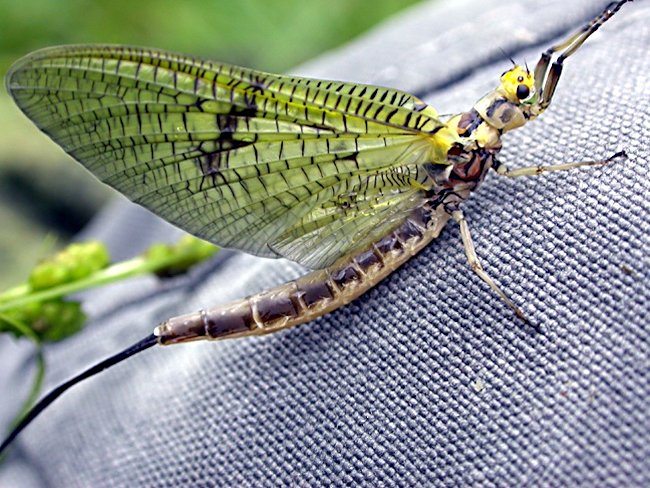The Green Drake Wulff Dry Fly
The Green Drake Wulff Dry fly is designed to be used on rough water. It is a very buoyant fly that catches grayling and trout.

WULFF DRY FLY PATTERNS. Hook size 10 12 14 - $US each
GREEN DRAKE MAYFLIES
There are a number of mayfly species that share the common name Green Drake. They are all slightly bigger than other hatching mayflies and in the trout’s eyes represent a substantial meal and worth pursuing. This is why they are a favourite fly to imitate for many fly fishermen. Even the larger trout will make the effort to rise to the surface to grab a chance of munching on this bounty. The largest Green Drakes (Drunella Grandis and Drunella Doddsi) normally hatch in late May to June. The smaller Green Drake (Drunella Flavilinea) will hatch later in the season around mid September.
I use a Brown Gold Ribbed Hares Ear nymph to imitate the Green Drake nymphs. I use a Gold bead head Brown GRHE nymph on the point fly and a normal one in the middle tied under a Green Drake Wulff dry fly pattern. That way I fish surface feeding trout as well as those taking the nymphs rising to the surface just before they emerge. I have found that Green Drake duns rarely hatch in large numbers and normally emerge on quiet runs. I have found the best strategy is to wait to see a feeding trout and cast up stream of its location and dead drift my team of flies over that location. I wait until the flies have moved past further down stream before I lift the line to make a new cast. Drag on your line can spook the feeding fish so I pay particular attention to the amount of line on the water. Never lose concentration as you lift the line. I have experienced some vicious takes as the fly leaves the water from fish that have been tracking the moving team of flies.

Later several other Wulff patterns, including the Grizzly Wulff, Black Wulff, Brown Wulff and Blonde Wulff were developed. Lee Wulff stated that these flies were a general kind of fly, not a particular pattern. When you first use Wulff flies treat with floatant and fish on the surface. Leave the fly to drift with the current. Occasionally accelerate it gently over short distances of a yard (meter) or more, or else twitch it to represent a struggling insect trapped in the surface film. They were first used in Britain in the 1950's but they saw very little service in Ireland until after 1990.
WHEN & HOW TO FISH BIG FLIES
On days when a cold wind ruffles the water surface, when the river or
stream is swollen from over night rains, that is the time to go for a big fly.
There is little likelihood of a hatch. Most anglers turn to their trusted nymph
patterns. Brake with the norm. Look for pockets and pools of calmer water where
the trout will take refuge from the fierce current. Work upstream and fish a big
fly into this gathering place. Let the fly drift for a little way and then give
it a gentle tweak to create a tiny wake on the water surface to suggest life. I
find it is best to check the flies progress with the rod tip rather than pulling
in the fly line to prevent line drag showing up un-naturally on the surface and
spooking the fish. Look for that small patch of calmer water directly behind
larger rocks or the quieter area found between two meeting currents. I have
found it best not to cast to the same area too often. A couple of casts to one
then move on to the next and then the next, then return to the first area
It is the large imprint on the water's surface that attracts the trout's attention. they are opportunists by nature and normally will not pass up such a substantial meal so long as it is cast and present correctly. As an experiment I cast one of these large flies during a hatch of tiny flies. The tiny fly designs in my fly box were the wrong color and not working. The fish were pre-occupied with supping down the surface feast. Casts that were not in front of the fish's nose were ignored, but get your large fly within it's forward target zone and whoosh, it would be taken in a greedy attack.
Because of the more extravagant hackles on these flies their aerodynamic qualities are not very good. Delicate presentations are difficult. I find slowing down on the cast helps and I use a stronger leader of about 5lb breaking strain. Do not even think of using fine tippets as you will end in an annoying tangled mess. In really windy weather I even use a heavier leader.
GOOGLE+ READER'S COMMENT
Wulff's are great in pocket water with droppers or alone. Mike Spillias, Virginia, USA
GOOGLE+ READER'S COMMENT
I like the Wulff #14 for the Galatin River and other mountain freestone streams. John Newbury, USA


Fly Fishing books

